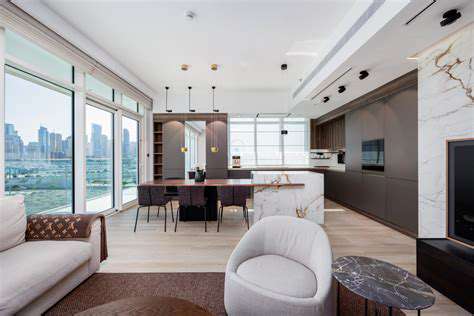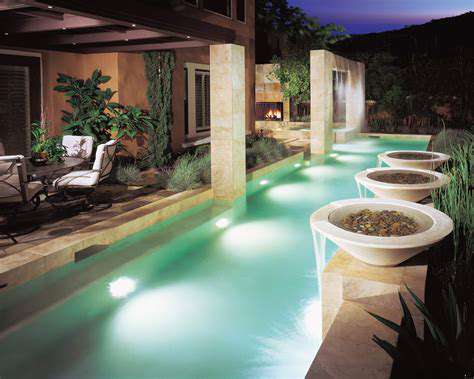Holistic wellness tips for designing your home
Understanding the Impact of Color
Color psychology plays a significant role in interior design, shaping our daily moods and emotional responses. Warm hues like crimson or tangerine can energize a room, whereas cool tones such as cerulean or sage often induce calm. The saturation level matters too - a bold ruby red energizes differently than a soft blush pink. These nuances let designers craft spaces that truly resonate with occupants' needs.
Lighting conditions dramatically alter color perception. A navy blue wall might feel cozy under warm lighting but cold under fluorescent bulbs. Always test paint samples at different times of day before committing to a color scheme. This attention to detail separates thoughtful design from haphazard decorating.
Choosing Colors for Specific Spaces
Sleep spaces demand careful color consideration. Pale aquamarine or muted lavender can lower heart rates, preparing the body for rest. For children's rooms, consider buttery yellows that stimulate creativity without overstimulating. Dining areas benefit from earthy terracottas that stimulate appetite and conversation.
Home offices present unique challenges. While some thrive in energizing citrus tones, others need serene greige for concentration. The key lies in personalizing color choices rather than following trends blindly. Always consider how colors make you feel personally - your visceral reaction matters more than design magazines' recommendations.
Beyond the Walls: Exploring Color in Decor
Textiles offer flexible color opportunities. Rotating seasonal throw pillows or area rugs lets you experiment without commitment. A saffron-hued velvet sofa makes a bold statement, while neutral upholstery allows colorful accessories to shine. Don't overlook ceilings - a pale sky blue overhead can create an airy, expansive feeling.
Artwork provides excellent color inspiration. Pull accent colors from a favorite painting or photograph. This creates visual harmony while telling your personal story through decor. Remember, cohesive doesn't mean matchy-matchy - varying textures and sheens add depth to monochromatic schemes.
Designing for Flow: Spatial Arrangement and Feng Shui Principles
Spatial Arrangement for a Calming Atmosphere
Thoughtful furniture placement dramatically impacts how we experience spaces. The breathing room principle suggests leaving 30-36 inches between seating pieces for comfortable circulation. Floating furniture away from walls often creates more intimate conversation areas than perimeter arrangements.
Traffic patterns should feel intuitive - people naturally gravitate toward diagonal paths between doorways. Position furniture to accommodate these natural movement flows rather than fighting against them. Area rugs help define zones in open-concept spaces without physical barriers.
Feng Shui Principles for Balanced Energy
The commanding position concept suggests placing beds and desks diagonally opposite room entrances. This placement provides security while maintaining visibility of the door - a primal comfort need. Avoid positioning seating with backs to windows or doors, which creates subconscious unease.
Mirrors require careful placement. While they can double light and expand small spaces, avoid positioning mirrors to reflect beds or front doors directly, as this may disrupt restful energy. Instead, angle mirrors to reflect beautiful views or art pieces.
The Importance of Natural Elements and Light
Biophilic design principles emphasize nature connections. Incorporate organic shapes through curved furniture or driftwood accents to soften modern interiors. Live-edge wood tables bring raw nature indoors while providing functional surfaces.
Window treatments should maximize daylight while providing privacy. Sheer linen curtains filter harsh sunlight beautifully, creating dappled light effects reminiscent of forest canopies. For south-facing rooms, consider UV-filtering window films to protect furnishings without sacrificing brightness.
Cultivating Calm: Natural Elements and the Importance of Light

Harnessing the Power of Nature
Indoor water features create multi-sensory experiences. A tabletop fountain's gentle burble provides auditory masking for urban noise pollution. For smaller spaces, terrariums with moisture-loving plants offer similar humidity benefits without maintenance hassles.
Natural materials age beautifully. Choose unfinished brass or copper pieces that develop rich patinas over time, telling your home's story visually. Reclaimed wood beams or flooring add instant character while being environmentally conscious choices.
The Importance of Natural Light
Light temperature matters for circadian rhythms. Install tunable LED bulbs that shift from energizing cool white to relaxing amber tones as evening approaches. For north-facing rooms, strategically placed mirrors can bounce available light deeper into spaces.
Consider light layering - combine ambient, task, and accent lighting for flexibility. Dimmable sconces or pendant lights allow precise mood-setting for different activities and times of day. Never rely solely on overhead lighting, which can create harsh shadows and visual fatigue.
Nurturing Wellbeing: Personal Touches and Emotional Connection

Prioritizing Self-Care
Create dedicated relaxation nooks. A window seat with plush cushions and a throw blanket invites spontaneous moments of respite. Even in small spaces, a comfortable chair with good lighting can become a personal retreat corner.
Display meaningful objects prominently. Family heirlooms, travel souvenirs, or children's artwork personalize spaces more effectively than generic decor. Rotate displayed items seasonally to keep your environment feeling fresh and intentional.
Maintaining a Balanced Lifestyle
Designate tech-free zones. Keeping bedrooms screen-free supports better sleep hygiene and more meaningful connections. Create charging stations away from living areas to discourage constant device checking.
Incorporate movement-friendly design. Standing desk converters or balance board options encourage subtle activity during work hours. Clear pathways for yoga or stretching make wellness practices more accessible daily.











